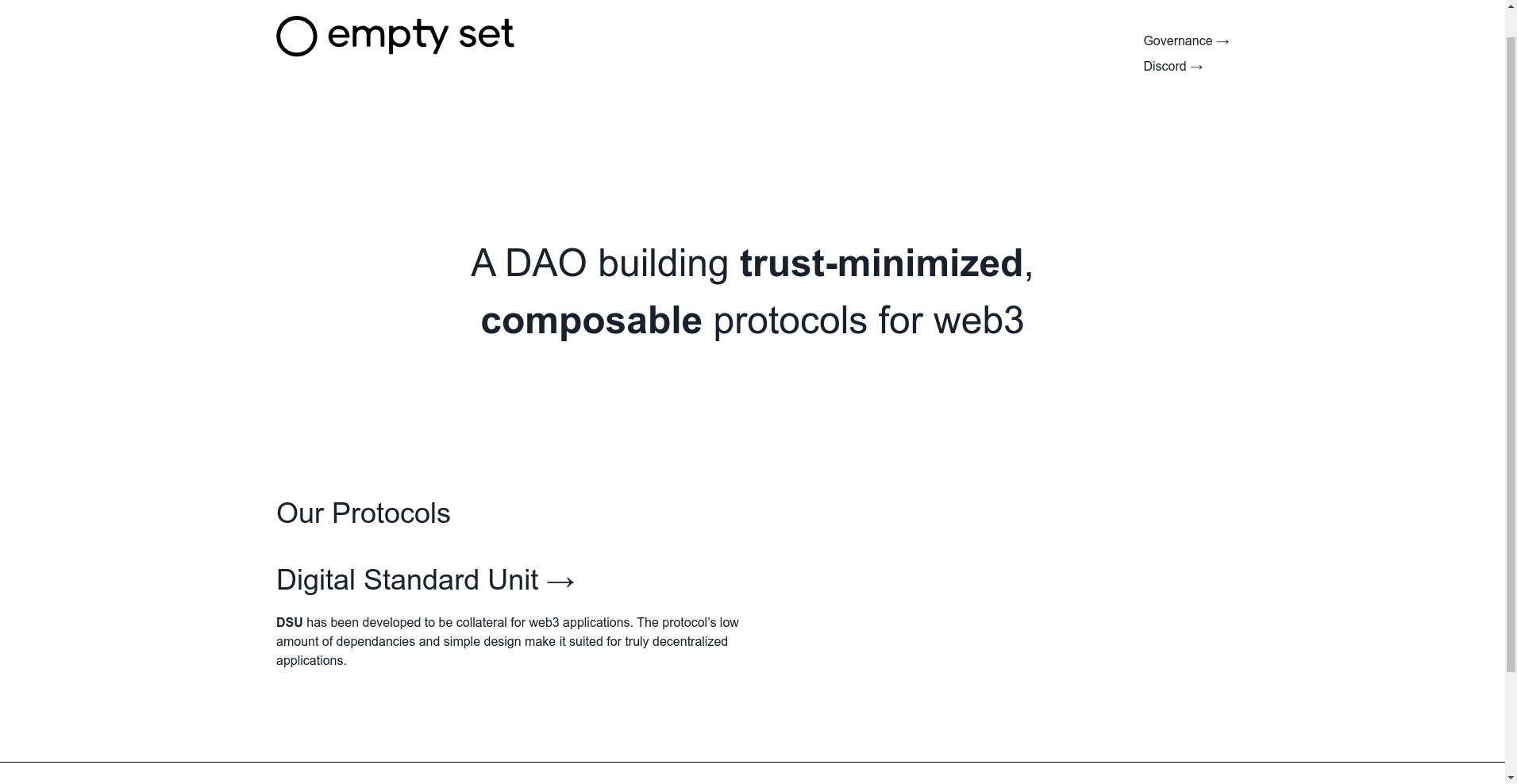Empty Set Dollar ($ESD) Review: A Data-Driven Look at Its Legitimacy and Risks

What Is Empty Set Dollar: An Introduction
Empty Set Dollar (ticker: $ESD) is a decentralized protocol within the web3 ecosystem aiming to create trust-minimized, composable financial primitives. Developed as part of the broader EmptySet Finance project, it focuses on building foundational components like collateral tokens that are designed to support decentralized applications (dApps) with minimal reliance on trusted third parties.
The protocol emphasizes simplicity, security, and community governance, positioning itself as a building block in DeFi infrastructure. As an open-source project with audited smart contracts, it seeks to balance innovation with the necessity of trust and security. This review provides an impartial, evidence-based analysis of its core strengths and potential vulnerabilities, scrutinizing its technological security, economic design, and project legitimacy.
The Team and Roadmap Evaluation
Regarding the team behind Empty Set Dollar, information is limited regarding publicly known individual founders or core contributors. Evidence suggests the project is driven by a decentralized community and potentially anonymous contributors, which is common in many DeFi projects. The emphasis on community governance via platforms like Discord indicates a leverage on collective decision-making rather than centralized leadership.
Examining the publicly available roadmap and milestones, key points include:
- Launch of core protocols like the Digital Standard Unit (DSU), designed for collateralized web3 applications.
- Implementation of governance frameworks to enable community proposals and voting.
- Audits conducted by reputable firms such as OpenZeppelin and Certik, highlighting a focus on security and transparency.
- Incremental improvements in protocol scalability, security, and ecosystem integrations.
While the roadmap suggests an active development process and a community-centric approach, the absence of detailed, community-verified technical milestones and the lack of transparent leadership history should be noted. The project appears to aim for steady delivery of its stated goals rather than rapid innovation, which is typical for protocols prioritizing security.
Assessing the Security and Integrity of Empty Set Dollar
Security assessment for Empty Set Dollar relies primarily on the audit report available from Cer.live, supplemented by the OpenZeppelin audit of its version 2 protocol. The Cer.live audit covers approximately 60% of the platform, focusing on the token's smart contracts, which is standard practice for DeFi projects. The audits conducted by reputable firms like OpenZeppelin and Certik lend credibility, but some caveats remain.
Key findings from the audit and security analysis include:
- Audit Ratings: The OpenZeppelin audit report provides a thorough review, emphasizing the security of core functionalities. Certik's review, focused on the token, mostly confirmed the absence of critical vulnerabilities but highlighted potential concerns around governance processes.
- Vulnerabilities Identified: Some issues related to reentrancy, access control, and upgradeability mechanisms were flagged but generally patched or addressed in subsequent protocol versions.
- Bug Bounties & Incidents: The absence of ongoing bug bounty programs and the presence of past incidents suggest room for improvement in proactive vulnerability identification.
- Platform Decentralization & Censorship Resistance: As a DAO-driven project, control is distributed among governance token holders. However, the security of governance mechanisms relies upon token distribution and multi-signature implementation, details of which are currently limited.
Overall, the security posture is moderately strong but not immune to risks inherent in DeFi protocols, especially those with governance systems susceptible to token concentration or governance attacks. Investors should remain cautious, monitoring governance activity and potential contract upgrades.
A Breakdown of Empty Set Dollar Tokenomics
The tokenomics of $ESD revolve around its role within the ecosystem as a governance and utility token designed to incentivize participation and secure protocol operations. The fundamental economic design aims to foster decentralization and long-term sustainability.
- Total Supply: The total supply is finite, but the exact cap varies based on protocol iterations and minting/burning mechanisms.
- Inflation/Deflation: The protocol incorporates mechanisms for inflation control, such as staking rewards or token burns based on activity, which influence the token’s value stability.
- Distribution:
- Team and Advisors: A modest percentage, often with vesting schedules, to align incentives.
- Community & Ecosystem: Allocated for liquidity mining, staking rewards, and governance incentives.
- Investors & VCs: Limited allocations to mitigate centralization risks.
- Vesting & Lockups: Typically, team tokens feature vesting over 1-2 years, with community and ecosystem allocations subject to lock-up periods to prevent dumping.
- Utility: $ESD functions as a governance token, enabling holders to influence protocol upgrades, parameter changes, and community proposals. It may also be used as collateral within the ecosystem.
The economic model seeks sustainability through controlled issuance and incentivization, but risks include centralization of voting power if token distribution concentrates, or inflationary pressures if emission controls weaken. The balance attained depends heavily on the ongoing governance and community engagement.
Assessing Empty Set Dollar's Development and Ecosystem Activity
Public data indicates ongoing development activity, including regular protocol updates, security audits, and community engagement efforts. The project's transparency is evidenced by posted audit reports and continuous communication via social channels like Discord and Telegram.
While marketing milestones and community growth initiatives are prominent, the true measure of ecosystem health rests on development sustainability and real-world adoption. Current indicators suggest steady progress rather than explosive growth, consistent with a protocol prioritizing security and robustness over hype-driven expansion.
Participation metrics, such as governance proposal submissions, staking activity, and liquidity provision, point toward a committed, if niche, user base. However, widespread adoption remains limited, and the protocol’s long-term viability depends on its ability to attract ongoing developer and user interest.
What Investors Should Know About Empty Set Dollar's Legal Terms
The project's legal framework largely revolves around open-source licenses and governance proposals. There is minimal evidence of formal legal structures or compliance measures, which is common in DeFi projects. Potential risks include regulatory scrutiny, especially regarding governance mechanisms that could resemble security interests or securities laws if not carefully structured.
Notably, the documentation does not specify investor protections or dispute resolution processes. Users engaging with the protocol should be aware of the typical risks—smart contract bugs, governance attacks, and market volatility—that are not mitigated by legal safeguards beyond community oversight.
Final Analysis: The Investment Case for Empty Set Dollar
Empty Set Dollar presents itself as an innovative, security-conscious project aiming to provide foundational protocol components for the web3 ecosystem. Its reliance on audited smart contracts, community governance, and a detailed roadmap suggest a serious stance on security and decentralization. However, inherent risks remain, especially related to governance security, token distribution, and the nascent stage of its ecosystem.
From a quantitative perspective, the project's security posture is moderate, but vulnerabilities identified in audits and the absence of a comprehensive bug bounty program highlight potential attack vectors. The tokenomics are designed to incentivize participation but could face challenges if centralization or inflationary pressures take hold. While Certik audits provide a degree of assurance, understanding audit completeness is crucial.
Widespread adoption and long-term viability will depend on the project's ability to maintain security, foster community engagement, and expand its ecosystem. As always, prospective investors should weigh the protocol’s strengths against its vulnerabilities and recognize that, as a protocol still in its growth phase, it carries inherent uncertainties.
In conclusion, while Empty Set Dollar holds promise as part of the evolving DeFi infrastructure, it remains a statistically risky bet. Interested parties should perform their due diligence, monitor governance activity, and consider how protocol security and tokenomics align with their risk tolerance.

James Carter
Chief On-Chain Analyst
On-chain analyst with a background in financial fraud detection. I use data science to dissect blockchains, find the truth, and expose scams. My motto: code doesn't lie.
Similar Projects
-
Peace Guy
Crypto Review: Is Peace Guy a Scam? Crypto Project Scam Checker & Honest Review
-
Pharaoh Kek
Pharaoh Kek: Data-Driven Post-Mortem and Analysis of Its Abandonment
-
Simba
Simba ($5-Simba) Review: Project Collapse & Risks Explained
-
IROSH
Comprehensive Review of IROSH - Is This Crypto Project a Scam? Crypto Scam Checker & Project Review
-
Quest Life
Quest Life ($QLIFE) Review: Analysis of Security & Abandonment